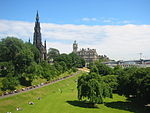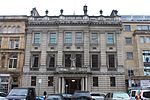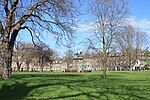Charlotte Chapel (Edinburgh)
1808 establishments in ScotlandBaptist churches in ScotlandCategory B listed buildings in EdinburghChurches in EdinburghListed churches in Edinburgh ... and 2 more
Religious organizations established in 1808Use British English from May 2017

The Charlotte Chapel, also known by its previous name, St George's West Church, is a historic church building located in Shandwick Place, Edinburgh, Scotland. It belongs to an Independent Baptist congregation, and was originally a parish church of the Church of Scotland.
Excerpt from the Wikipedia article Charlotte Chapel (Edinburgh) (License: CC BY-SA 3.0, Authors, Images).Charlotte Chapel (Edinburgh)
Rose Street, City of Edinburgh New Town
Geographical coordinates (GPS) Address Nearby Places Show on map
Geographical coordinates (GPS)
| Latitude | Longitude |
|---|---|
| N 55.951388888889 ° | E -3.205 ° |
Address
Rose Street 196
EH2 3DT City of Edinburgh, New Town
Scotland, United Kingdom
Open on Google Maps










